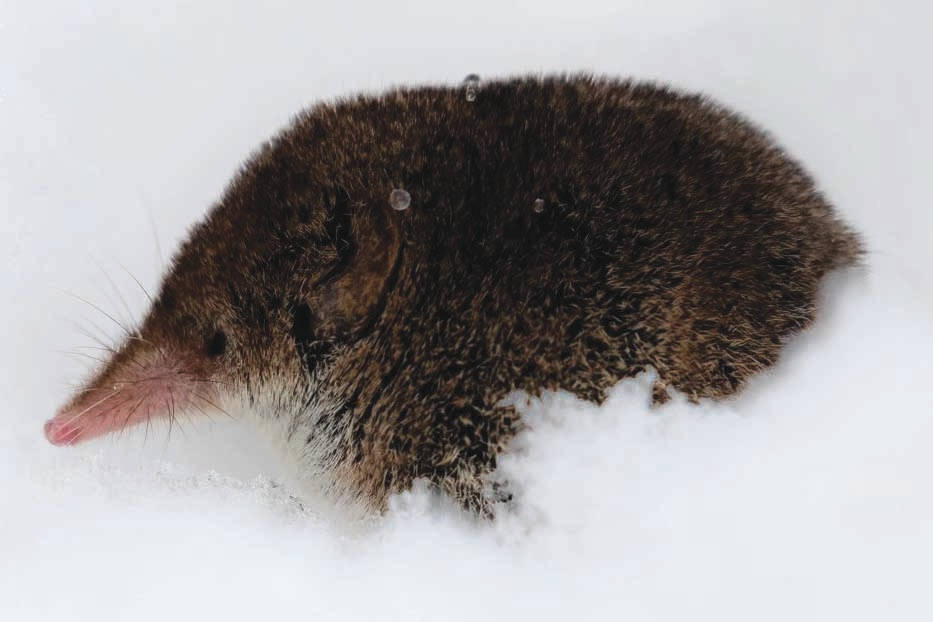Alaska summers are fast paced with people, wildlife and plants all in apparent frenzy trying to capitalize on warm temperatures and sunlight. And with good reason: winter is always looming just around the corner.
During winter, much of life seems to slow down and relax. Bears go into dens to hibernate and many birds fly south to avoid winter. Many wildlife species simply tough out the harsh winters waiting for better days to come. Other species, however, capitalize on a hidden winter habitat.
Often overlooked and seldom seen, many small mammals are basically going about business as usual in a realm known as the subnivean. As with many scientific terms, the word subnivean is descriptive and comes from Latin, describing a place “under” (sub) “snow” (nivis).
To us, looking from above, the subnivean looks like a solid blanket of snow and it’s hard to imagine anything living in it. Underneath the snowpack, however, lies another world.
When the inevitable snows of winter fall and cover the landscape in snow, vegetation and rocks shelter the ground underneath from snow buildup.
As snows continue to build up and the snowpack forms above, heat radiating from the ground causes the ice crystals near the ground to sublimate into water vapors, rise and refreeze above as an ice layer. This process creates a snow-free zone between the ground and the bottom of the snowpack, known as the subnivean zone.
Voles, shrews, lemmings and other small mammals thrive in this subnivean zone where they can weather even the harshest Alaska winters in relative comfort.
Voles and shrews are among the smallest mammals in Alaska. Because of their small body size and high metabolic demands, most cannot survive cold temperatures for very long.
In the subnivean zone, however, the snowpack serves as an insulating layer from colder temperatures and winds above. With temperatures typically remaining above freezing all winter, small mammals exploit this warmer zone where they can move about in relative freedom.
In the subnivean zone, small mammals are active throughout the winter and create extensive snow tunnel networks to travel between foraging areas, food caches, nests and latrine sites.
Small mammals also dig up through the snow to create air shafts that allow fresh air to circulate through their tunnel networks. Because temperatures are generally above freezing in the subnivean zone, the foods that small mammals rely on, such as grasses, leaves, seeds and insects, generally remain unfrozen and accessible.
The layer of snow and ice above also offers increased protection from predators that prey on small mammals. As might be expected, however, the subnivean zone is not exactly a paradise for small mammals either.
Some predators have, of course, also figured out how to exploit small mammals in the subnivean zone. Intuitively, larger predators cannot see small mammals under snow, but some species have evolved attributes or behaviors that use other senses and allow them to effectively hunt small mammals in their subnivean lairs.
Coyotes and foxes, for example, locate small mammals under the snow by sound. Once prey has been located they leap into the air and pounce down on unsuspecting prey.
Although these predators use this technique year-round, it is particularly effective for hunting small mammals in the subnivean zone because the layer of snow helps conceal the predator’s approach, allowing them to close the distance quickly, without being seen, and break through the snow to catch prey beneath.
Owls have mastered a similar technique whereby they locate prey moving under the snow by sound with astounding accuracy. Their ability to pinpoint sounds made by small mammals under the snow is aided by their dish-shaped faces, which help funnel sounds to their ear openings, and by asymmetric ear openings that allow owls to accurately pinpoint sounds in both horizontal and vertical planes.
Once prey is located under the snow, owls simply glide into position on silent wings, and dive through the snow to catch prey underneath.
Predators above the snow are not the only thing with which small mammals in the subnivean must contend. Smaller mustelids, such as least weasel and ermine, also take advantage of the warmer temperatures in the subnivean zone.
And, since these mustelids forage primarily on small mammals, the subnivean zone offers not only shelter from cold temperatures, but also an abundance of small mammal prey. With their small size and elongated bodies, least weasels can effectively navigate the myriad tunnels and clearings in the subnivean zone and are a major predator of small mammals.
Although the hidden subnivean remains largely out of sight, it’s always fun to think about the populations of creatures thriving just out of view under the snow.
Dom Watts is a Wildlife Biologist at Kenai National Wildlife Refuge. Find more Refuge Notebook articles (1999–present) at https://www.fws.gov/refuge/Kenai/community/refuge_notebook.html.
By DOM WATTS
Kenai National Wildlife Refuge



